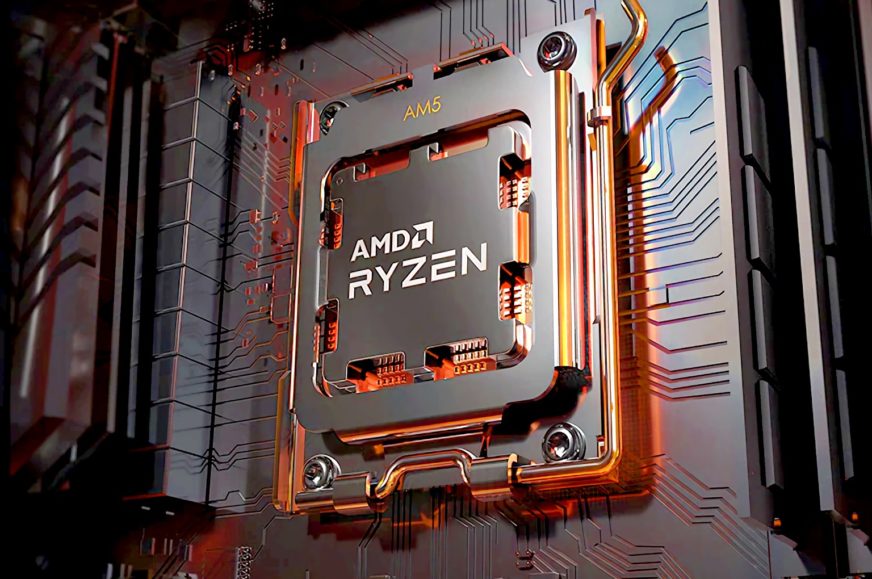AM5 platform detailed. Official information and leaked chipset specifications
This week, AMD unveiled the Ryzen 7000 CPUs and Zen 4 architecture at Computex 2022. These new desktop processors will also introduce a brand new platform with the AM5 socket and new chipsets – B650, X670 and X670E. We now have details of these platforms and an overview of the connectivity that the AM5 boards will offer. Some of it has been revealed directly by AMD, but there’s also an unofficial leak with many more details.
The AM5 platform is designed to be flexible and future-proofed with a variety of new high-speed interfaces, according to AMD. Like its predecessor, it should last for multiple generations. It will overlap with the AM4 socket for some time. AMD has confirmed that boards and processors of this previous platform will continue to be on sale for some years, mainly to complement the cheaper offerings and also because the (at this time) cheaper DDR4 memory will not be supported on AM5.
New socket, new power supply
Socket AM5 will have 1718 pins in the socket. It will be a LGA type socket, as used in Intel desktop, there will only be contact pads on the processor itself. The LGA system allows for a higher pin density, but the manufacturing cost is slightly higher. The CPUs themselves will be less susceptible to damage (CPUs with pins are particularly at risk of pin bending when dropped on the floor or when the cooler is carelessly removed – if you want to avoid this, always twist the cooler first until you feel that its grip on the CPU has loosened, only then lift it up). But in turn, you will need to be more careful with the board. Accidental bending or damaging of pins on LGA boards is something that happens less commonly, but it is much harder to fix such damage than fixing bent pins on CPUs.
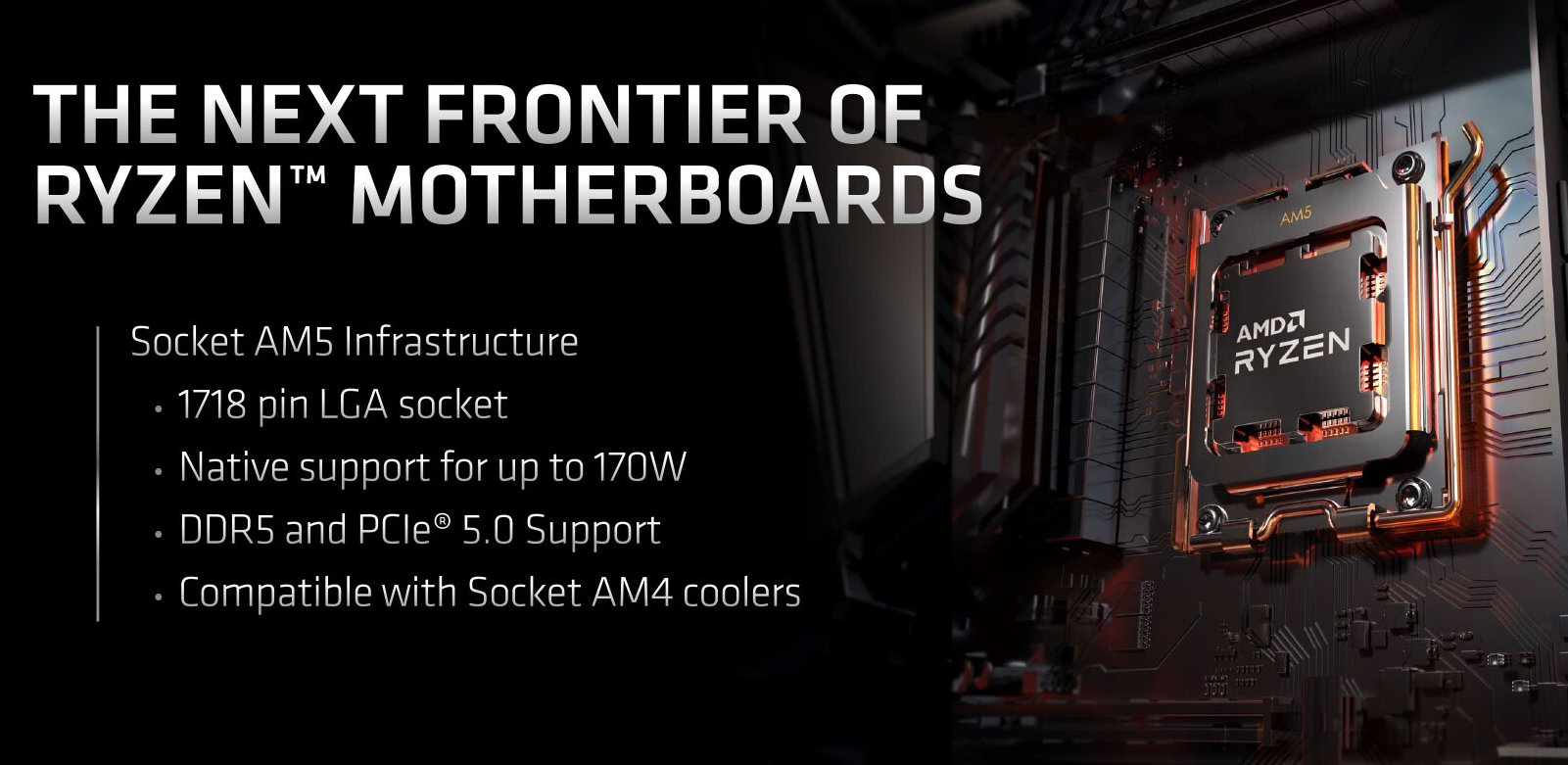
170 W: TDP, or maximum power draw (PPT)?
AMD has also confirmed that the AM5 platform will support up to 170 W TDP. At first there was no word on whether the PPT, the actual maximum sustained power draw, will also be increased. The PPT is 142 W for 105W Ryzen CPUs today.
AMD later shared information according to which the 170W value was actually not a TDP number, but instead a maximum power of the socket infrastructure. In other words, the PPT itself would be 170 W and the processors would not exceed this power consumption. It remains to be seen if this is the final answer or if there will be further changes in this story, but for now it seems that the maximum power consumption in the Ryzen 7000 CPU generation (and likely the others coming to AM5 later) will be this number, 170 W. It is perhaps possible that 170W will be both the TDP and at the same time the PPT of the highest-performance SKUs. We would certainly not mind the TDP vs. PPT discrepancies going away.
If 170W is the absolute maximum (unless you start unlocking and overclocking…), it wouldn’t be such a drastic increase in power and AMD would still maintain significantly lower maximum power draw than the current 241 W Intel processors (not to mention the previous 250 W generations). In any case, the increase in allowable power draw gives the potential for higher performance in processors with a large number of cores (16 or more).
Updated (26. 5. 2022): The above is not true any more. AMD has corrected its earlier message and clarified that the maximum possible power draw of an AM5 processor is much higher 230 W. It turns out that at the top, there will be two class of processors: SKUs with 125W TDP, which will have a 170 PPT (maximum power). However, there will be a separate SKU class with 170W TDP, and these will have accordingly higher PPT of 230 W as their maximum power consumption. We apologize for this confusion.
It’s possible the 170W TDP class might not be very common and only reserved for some extreme edition processors, but this remains to be seen. According to AMD, the processor demoed at Computex in the Blender multithread benchmark had a 170W PPT (meaning it supposedly was a 125W TDP SKU), so at least that presented performance didn’t need the 230W power draw. The sample was a sixteen-core processor, so hopefully there will be full-corecount Ryzen 7000 options available with the lower 125W TDP.
The AM5 platform will use a new processor voltage management infrastructure called SPI3 (AM4 had SPI2). SPI3 will support more phases, finer-grained voltage control and should also support faster voltage changes. This should improve efficiency, but also allow for higher performance.
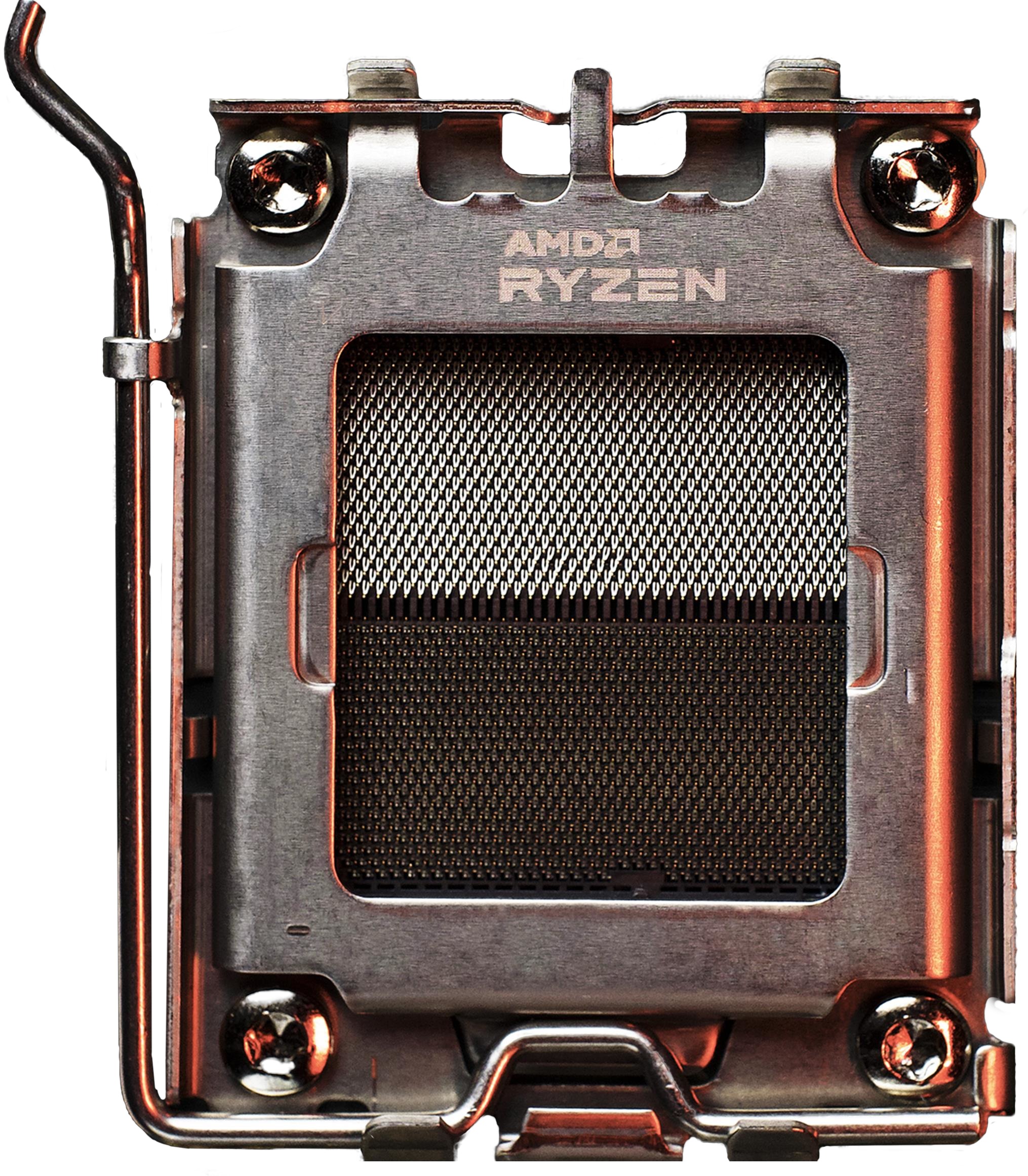
Connectivity from CPU: PCIe 5.0, DDR5
According to AMD, AM5 will only support DDR5 memory, there will be no boards for older DDR4 memory (unlike how Intel has kept both DDR4 and DDR5 support on the LGA 1700 platform). Therefore, purchasing new RAM will be a necessity. The controller is dual-channel, so at most the boards will have the classic four DIMM slots.
Processors for socket AM5 will support PCI Express 5.0 (right away in the Ryzen 7000 generation, so earlier reports that they would only have PCIe 4.0 are no longer valid). And at the same time, the number of lanes provided from the processor will be increased straight to 24, all of which will be PCIe 5.0 standard.
Of these 24 lines, 16 will be used for GPUs (with the option to split the ×16 into ×8/×8 for two cards), with the remaining eight being split into ×4 and ×4 interfaces. One of them will always be dedicated to NVMe SSDs, the other can either be used for a second M.2 slot for SSDs or can be used to attach a USB4 controller (which would also add compatibility with Thunderbolt 3 or 4). This can either be a controller from ASMedia or also from Intel, it seems.
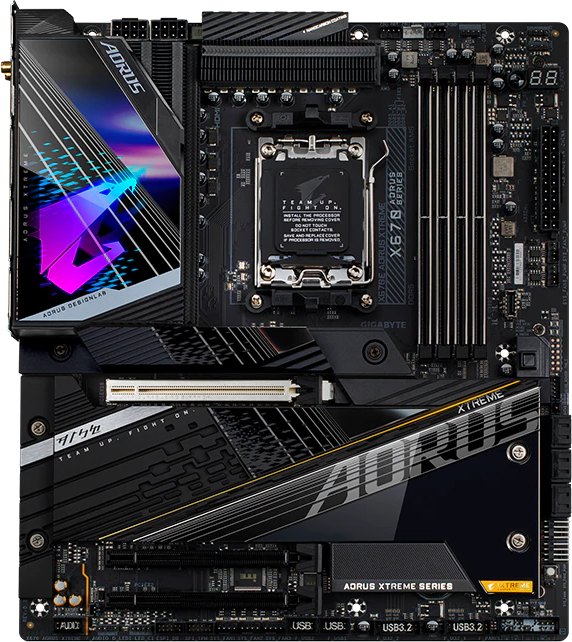
There is no PCIe 5.0 SSD option on Intel processor boards yet, PCIe 5.0 is reserved for GPUs on Alder Lake processors. There are also no SSDs that can use PCIe 5.0 ×4 yet, but that should change soon. AMD has been working with Phison (and reportedly Micron as well) to have a controller ready for such SSDs, so this capability could hopefully be usable in practice soon after the AM5 platform launches.
Integrated graphics in AM5 socket processors will be able to have up to four DisplayPort 2.0 or HDMI 2.1 video outputs. Three of these outputs will also be able to be wired via USB-C (USB4) ports. Overall, the AM5 platform is supposed to be able to support up to 14 USB-C 3.2 Gen 2 (SuperSpeed 10Gpbs) or Gen 2×2 (SuperSpeed 20Gpbs) ports, but that already includes connectivity from add-on chipsets, as we’ll see.
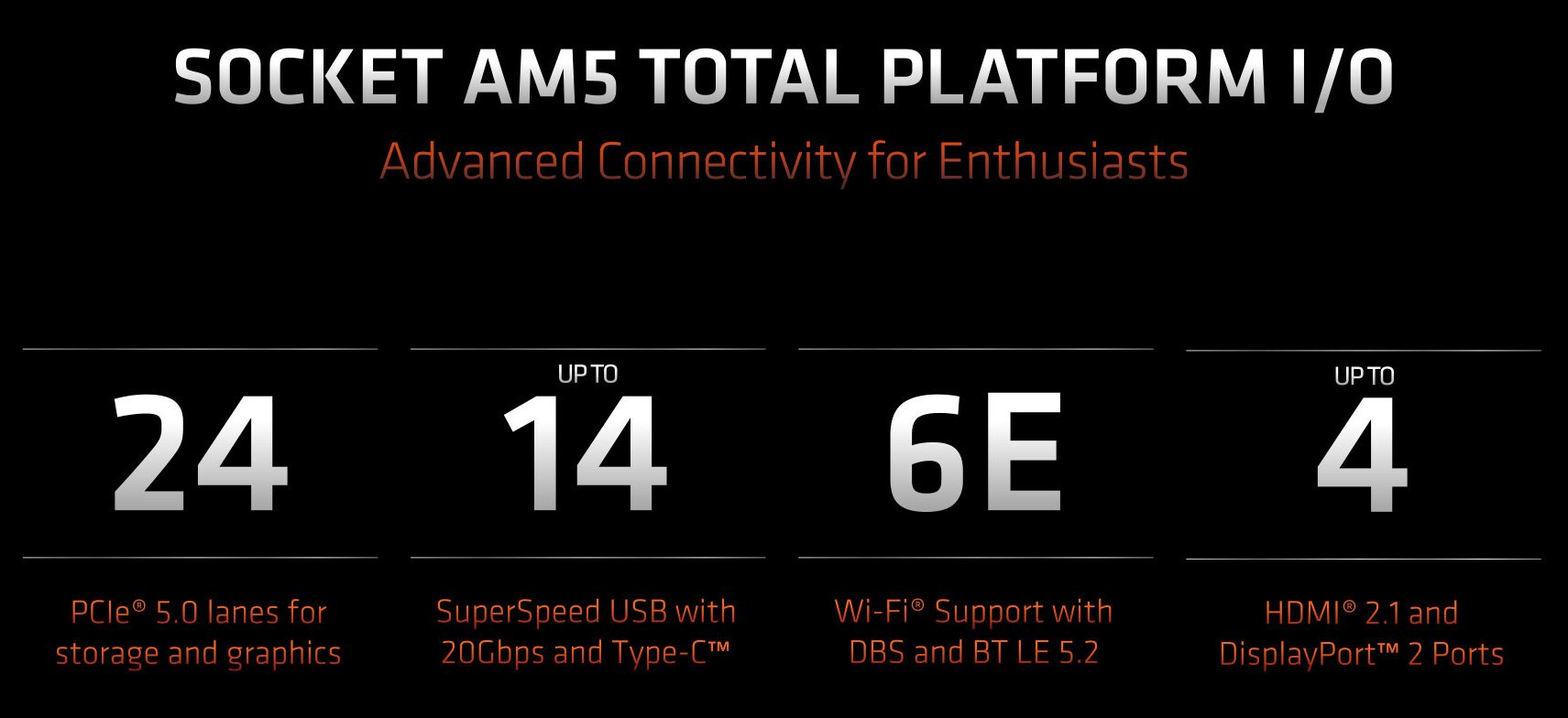
Compatibility with coolers for AM4
AM4 socket coolers can be used for cooling. AMD has again confirmed compatibility with their mounting system and mounting hole spacing for this new socket as well. At the very least, the coolers that use the default backplate that comes with AM4 boards will work. If the cooler uses a custom backplate instead, this backplate will need to be replaced with a new one – as there are likely to be changes to the back side of PCB under the socket that make AM4 backplates incompatible .
Chipsets: differences in connectivity
So far, the talk has been about the connectivity that the processor provides (or at least potentially can provide). Additional connectivity will be supplied by add-on chipsets on the motherboard. Their capabilities vary, while a particular chipset also determines the availability of some of the connectivity features from the processor – so the chipset designation indicates something more like the overall category of the board.
AMD only vaguely mentioned the specifications of these chipsets at Computex. But on Sunday, an unofficial leak appeared on the Angstronomics website. The website is newly established, someone seems to have waited for this opportunity to kickstart it with this leak. Better take these unofficial figures with a grain of salt for now, as there is no proven track record with this source yet, but they seem quite plausible.

Although AMD hasn’t confirmed it directly yet, it seems to be certain that all chipsets on the AM5 platform will consist of a single chip developed by ASMedia. The cheap and mainstream variants (A620 and B650) will have only one of these chips, and will therefore look a lot like the A520 and B550. The more expensive versions of the X670 and X670E will simply be made up of two of these chips on the board, and their connectivity will more or less add up.
X670E, X670
The most premium versions of the AM5 platform will be boards with a chipset labelled X670E or X670 Extreme. The X670E platform boards will always support PCI Express 5.0 on the M.2 slots for SSDs and also on the graphics card slots. And it should probably be true for split scenario as well, i.e. PCIe 5.0 ×8/×8 will be supported. The slides even mention “PCIe 5.0 everywhere”, but they probably only mean this delineation by that. It doesn’t mean that even the additional slots wired out of the chipset will have 5.0 speed (spoiler: the chipset will only provide PCIe 4.0 and 3.0 lines).
The X670 boards will be slightly less strict with PCIe 5.0. AMD states that the requirement will be that at least one M.2 slot for the SSD brought out from the CPU supports PCIe 5.0×4. These boards can probably support PCIe 5.0×16 for graphics card, but it seems that this will not be mandatory but optional. At least some X670 boards (possibly majority of them, even) will only have a PCIe 4.0×16 slot for the GPU, unlike the X670E ones.
B650: still PCIe 5.0, but only for SSDs
Boards with the B650 chipset will be designed with a more reasonable price points in mind. Whether there will be any exceptions with PCIe 5.0 for graphics cards is uncertain.
But heads up, according to AMD, it will be mandatory for B650 boards to have at least one M.2 slot with PCIe 5.0×4 connectivity for the SSD brought out from the CPU. Thus you will be able to fully utilise the latest SSDs even on the B650 platform.
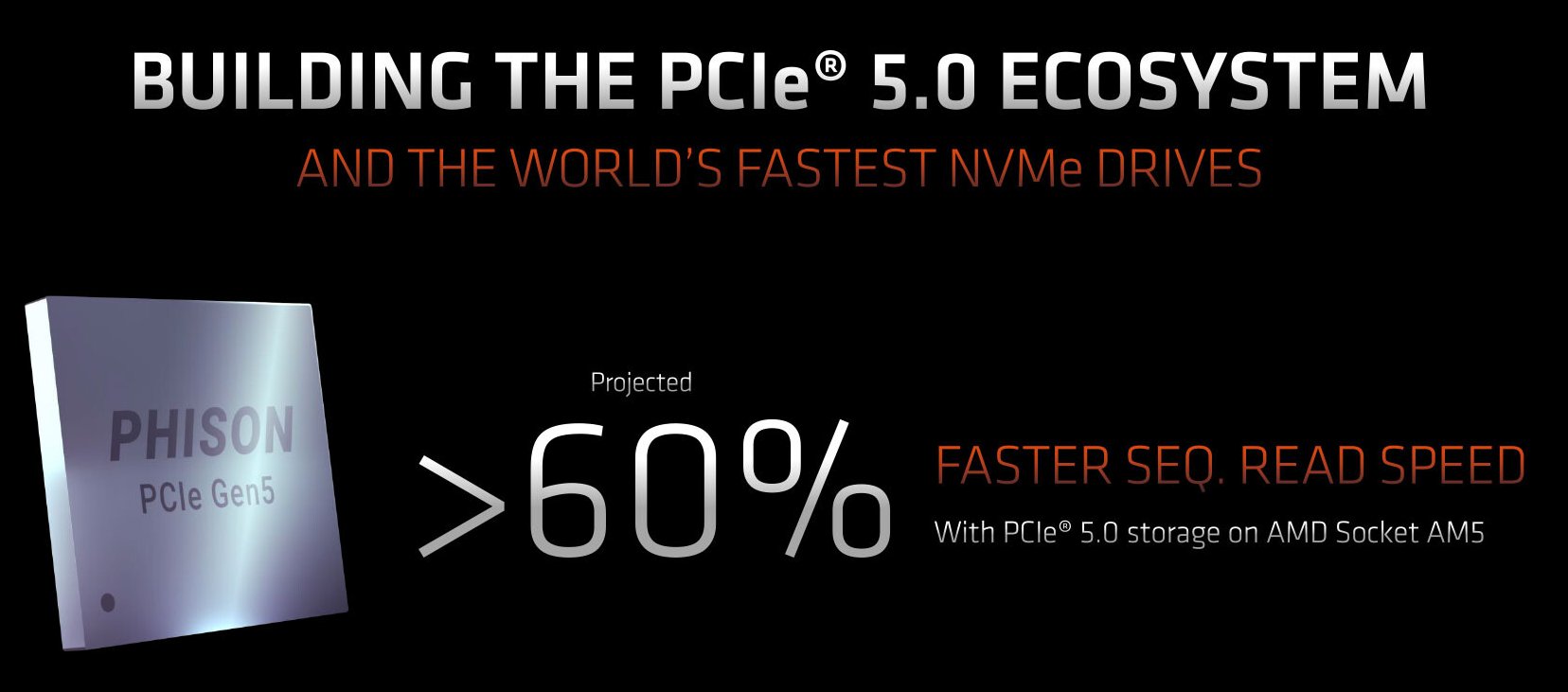
This is probably a good compromise, as the higher PCI Express speeds are more usable for SSDs than GPUs (at least things have been like that in the past and it doesn’t seem to be changing). At the same time, just a four-lane SSD interface could perhaps be feasible with less negative impact on board price than a full-fledged ×16 slot. The noteworthy thing is that the B650 platform will essentially be the reverse of Intel Z690/H670/etc., in this regard.
Detailed, if unconfirmed specifications leak
This was the official data, now let’s add those unofficial allegedly leaked details according to Angstronomics. According to this site, the chip used is internally referred to as Promontory 21 or Prom21 by ASMedia and it is a silicon with a BGA package measuring 19 × 19 mm and with a TDP of about 7 W. This is similar to Intel’s desktop chipsets and it can be normally cooled by a passive cooler, so hopefully there will be no need for fans like with X570.
The Promontory 21 chip in the basic configuration of the B650 chipset connects to the CPU via PCIe 4.0 ×4, i.e. with the same bandwidth (8 GB/s bidirectional) as the AMD X570, but only half the 16 GB/s bandwidth of the DMI 4.0 ×8 interface of the Intel Z690 chipset. Two PCIe 4.0 ×4 interfaces (8 lanes in total) and four PCIe 3.0 lanes are then brought out of the chipset. Board manufacturers can switch the PCIe 3.0 lines to SATA 6 Gb/s ports instead, as required (you can have combinations of 2× SATA + 2× PCIe or 4× SATA + 0× PCIe, for example). These Gen3 lanes are mainly to be used by Ethernet and Wi-Fi adapters on the board, leaving the remaining PCIe 4.0 lanes free for M.2 slots and PCI Express expansion card slots.
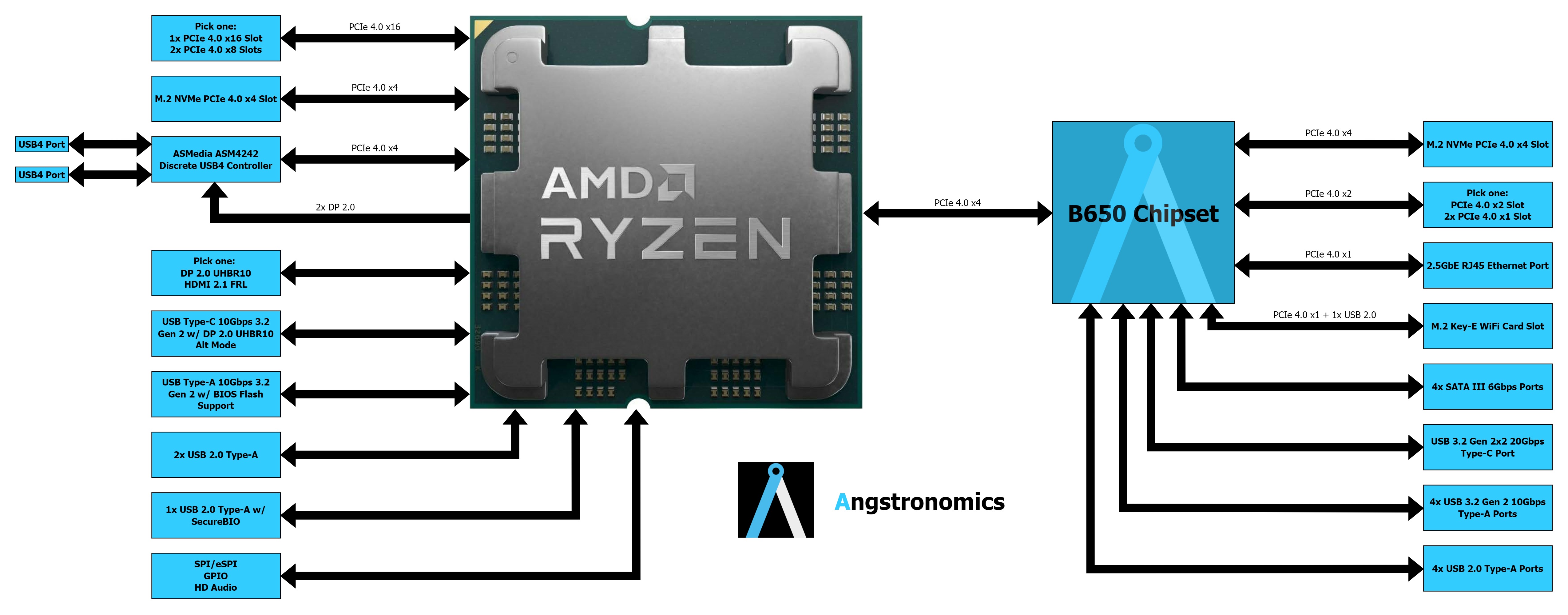
The chipset itself cannot do USB4, this can be supplied by an external controller that connects to the CPU lanes, as already mentioned. However, the B650 does support four USB 3.2 Gen 2 or SuperSpeed USB 10 Gbps ports and two more such ports, which can alternatively be configured as a single USB 3.2 Gen 2×2/SuperSpeed USB 20 Gbps port. In addition to these high-speed ports, the chipset then supports six more regular USB 2.0 ports. Recall that the processor itself adds three high-speed USB ports and two M.2 interfaces for SSDs to this chipset connectivity.
The A620 chipset is said not to be much different, according to Angstronomics virtually all capabilities are retained, only instead of eight PCIe 4.0 lanes this chipset has only four.
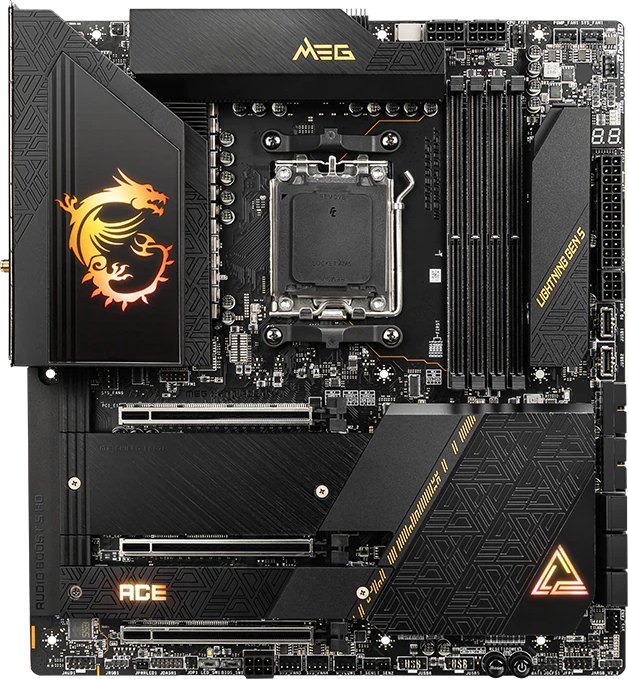
X670 and X670E are connected daisy-chain style, also serve as retimers
In the more premium configuration of the X670 and X670E chipsets, there’s two Prom21 chips connected. But contrary to initial expectations, they are not conencted to the CPU in parallel. AMD does this by having the first chip connect to the CPU via a PCIe 4.0×4 interface just like the B650. But the second chip is daisy-chained to one of the PCIe 4.0 ×4 interfaces of the first chip. So the resulting connectivity of the entire chipset (literally a chipset now, for a change) is doubled, except for the PCIe 4.0 lanes, where that one Gen4 ×4 interface is consumed by the daisy-chain coneection.
Three PCIe 4.0 ×4 interfaces (12 lanes in total) and eight PCIe 3.0 lanes are then brought out of the combined chipset. Again, board manufacturers can switch the Gen3 lines to SATA 6 Gb/s ports instead as required (you can have combinations of 6× SATA + 2× PCIe or 4× + 4×).
The USB connectivity is also quite decent, again adding up the capabilities of the two Promontory 21 packages. The X670/X670E chipset thus supports eight USB 3.2 Gen 2/SuperSpeed USB 10 Gbps ports and another four such ports that can alternatively be configured as a pair of USB 3.2 Gen 2×2/SuperSpeed USB 20 Gbps ports. And it supports additional 12 USB 2.0 ports.
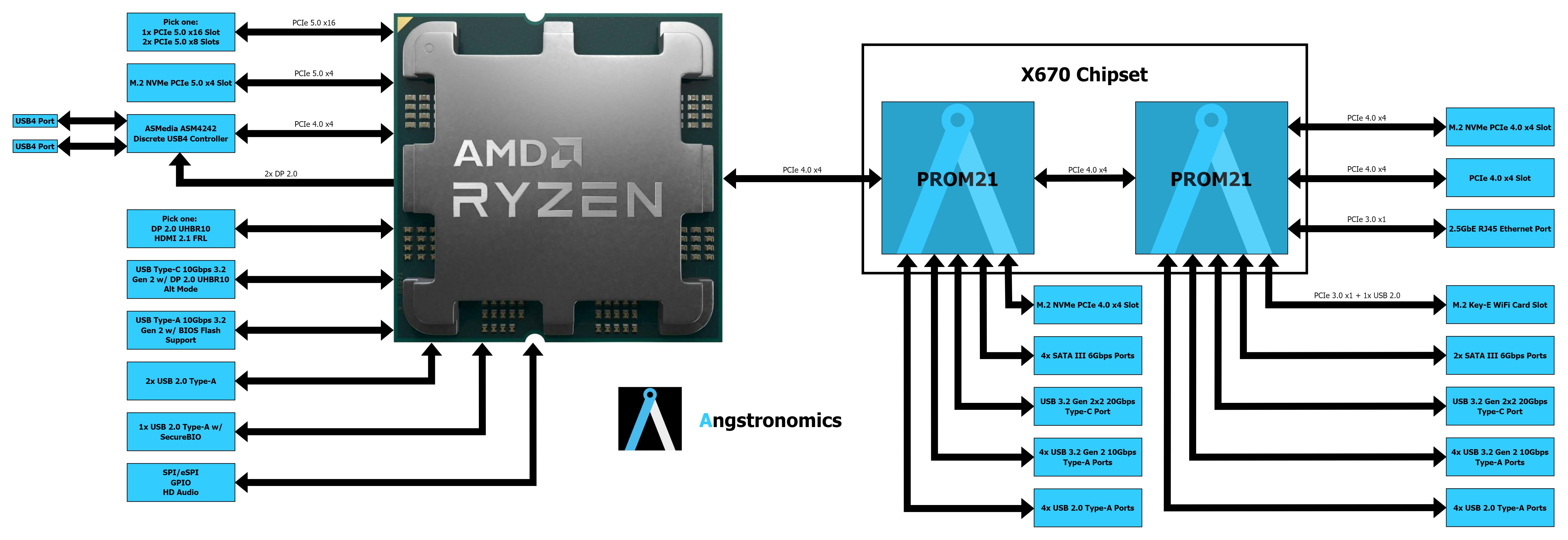
So the TDP is 7+7 W, but the chips will typically be placed further apart on the board, so passive coolers should still be enough to cool them. The fact that one chipset’s uplink is wired to the downlink connectivity of the other will probably cause some complications. For example, virtualization scenarios will create a non-trivial device tree and also SSDs connected up to the second chipset will have higher communication latency than the SSDs connected to the first.
On the other hand there might be some advantages too (besides the fact that it will make production more efficient and possibly cheaper than designing another bigger chipset for more expensive boards). These chipsets may be a bit of a substitute for PCIe 4.0 interface retimer (repeater) chips. Daisy-chained wiring allows the lanes from the other chipset to reach further away from the processor without having to use extra retimers. So the first chipset should probably serve the slots closer to the socket, the PCIe 4.0 lanes from the second chipset will be able to serve the PCIe and M.2 slots at the far (lower) end of the motherboard. Though on the flip side, there is also the possibility that the PCB design will get more complicated (and more expensive) due to the two positions needed for Promontory 21.
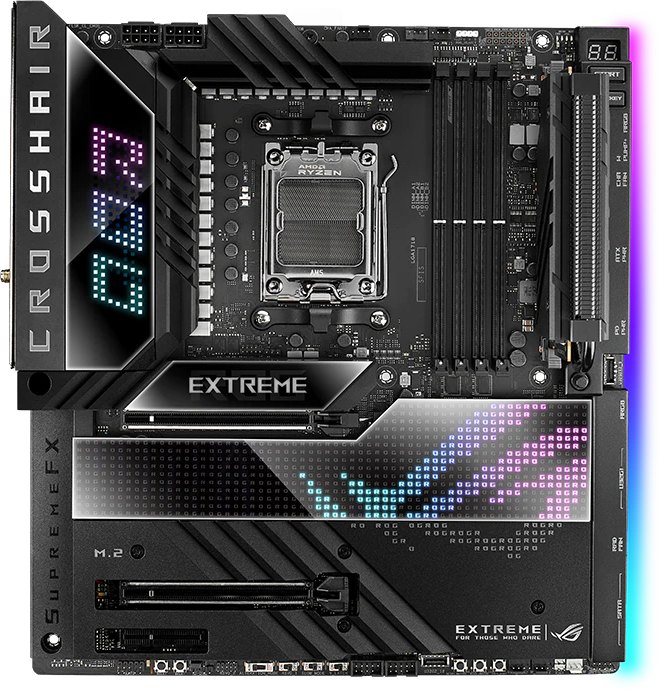
In any case though, these oddities will only occur with the X670 and X670E platforms. If you buy a mainstream board with a B650 or A620 chipset, you don’t have to worry about them, you will get a board that is completely conventional, just like the B550 platform was.
Sources: AMD (1, 2), Angstronomics, TechPowerUp
English translation and edit by Jozef Dudáš, original text by Jan Olšan, editor for Cnews.cz
⠀





